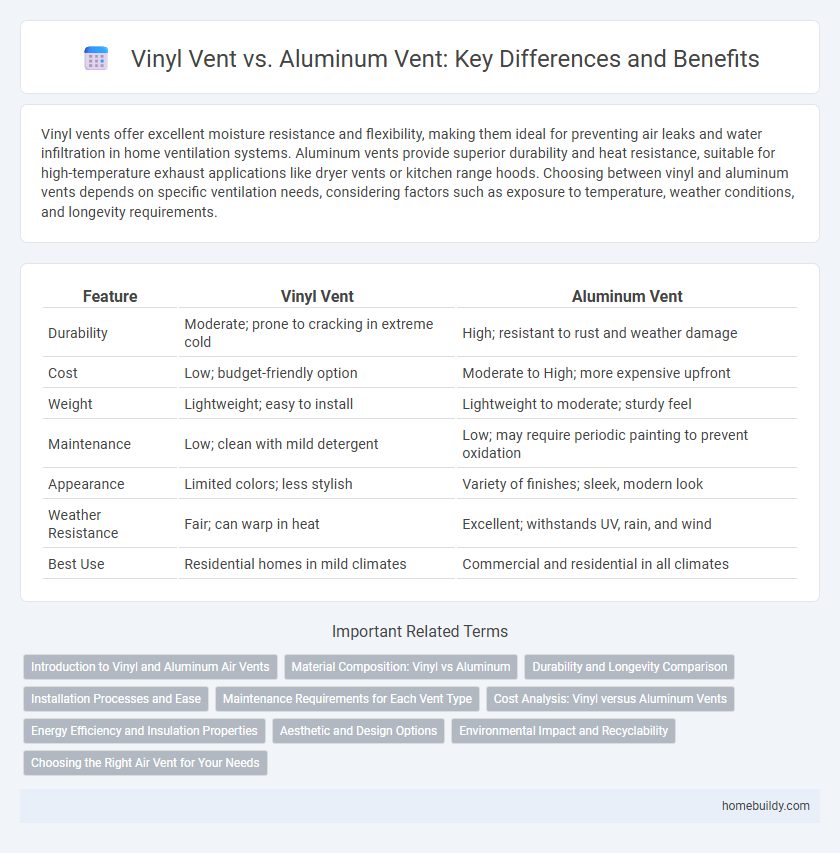Vinyl vents offer excellent moisture resistance and flexibility, making them ideal for preventing air leaks and water infiltration in home ventilation systems. Aluminum vents provide superior durability and heat resistance, suitable for high-temperature exhaust applications like dryer vents or kitchen range hoods. Choosing between vinyl and aluminum vents depends on specific ventilation needs, considering factors such as exposure to temperature, weather conditions, and longevity requirements.
Table of Comparison
| Feature | Vinyl Vent | Aluminum Vent |
|---|---|---|
| Durability | Moderate; prone to cracking in extreme cold | High; resistant to rust and weather damage |
| Cost | Low; budget-friendly option | Moderate to High; more expensive upfront |
| Weight | Lightweight; easy to install | Lightweight to moderate; sturdy feel |
| Maintenance | Low; clean with mild detergent | Low; may require periodic painting to prevent oxidation |
| Appearance | Limited colors; less stylish | Variety of finishes; sleek, modern look |
| Weather Resistance | Fair; can warp in heat | Excellent; withstands UV, rain, and wind |
| Best Use | Residential homes in mild climates | Commercial and residential in all climates |
Introduction to Vinyl and Aluminum Air Vents
Vinyl air vents offer durability and resistance to rust and corrosion, making them ideal for humid environments. Aluminum air vents provide lightweight strength with superior heat resistance and are commonly used in industrial and commercial settings. Both materials ensure efficient airflow but differ in maintenance requirements and environmental durability.
Material Composition: Vinyl vs Aluminum
Vinyl vents are made from synthetic plastic polymers, offering lightweight durability and resistance to corrosion but may warp under high temperatures. Aluminum vents consist of a metal alloy known for its strength, heat resistance, and long-lasting performance, making them ideal for harsh weather conditions. The choice between vinyl and aluminum hinges on factors like environmental exposure, durability requirements, and maintenance preferences.
Durability and Longevity Comparison
Vinyl vents offer moderate durability but tend to degrade over time when exposed to extreme weather conditions, leading to potential cracking and warping. Aluminum vents provide superior longevity due to their resistance to rust, corrosion, and UV damage, making them ideal for long-term use in various climates. Choosing aluminum vents enhances the lifespan of ventilation systems and reduces maintenance costs compared to vinyl options.
Installation Processes and Ease
Vinyl vents typically offer easier installation due to their lightweight nature and flexibility, allowing for quick cutting and fitting without specialized tools. Aluminum vents require more precise measurements and tools such as snips or metal cutters, along with additional care to avoid sharp edges, making installation moderately more complex. The durability of aluminum vents often justifies the extra effort in installation, especially for long-term ventilation needs.
Maintenance Requirements for Each Vent Type
Vinyl vents require minimal maintenance, as they resist corrosion and do not need painting, but may become brittle over time due to UV exposure. Aluminum vents are durable and withstand extreme weather, yet they need regular inspection for dents and oxidation, which can be addressed with occasional cleaning and repainting. Choosing between the two depends on balancing maintenance effort with long-term durability in specific environmental conditions.
Cost Analysis: Vinyl versus Aluminum Vents
Vinyl vents typically cost 20-40% less than aluminum vents, making them a budget-friendly option for homeowners. Aluminum vents offer greater durability and resistance to weathering, which can reduce long-term maintenance expenses despite the higher upfront cost. When assessing total cost of ownership, the initial savings with vinyl may be offset by its shorter lifespan compared to aluminum alternatives.
Energy Efficiency and Insulation Properties
Vinyl vents offer superior insulation properties due to their low thermal conductivity, reducing heat transfer and enhancing energy efficiency. Aluminum vents, while durable and resistant to corrosion, conduct heat more easily, potentially leading to greater energy loss in heating and cooling systems. Choosing vinyl vents can contribute to lower energy bills by improving overall thermal performance and minimizing air leakage.
Aesthetic and Design Options
Vinyl vents offer a variety of colors and textures that blend seamlessly with modern home exteriors, providing a subtle and uniform appearance. Aluminum vents deliver a sleek, contemporary look with customizable finishes, including brushed, painted, or anodized options, enhancing architectural style. Both materials support diverse design choices but aluminum is preferred for a more polished, high-end aesthetic.
Environmental Impact and Recyclability
Vinyl vents generate more environmental pollution during production and have limited recyclability compared to aluminum vents, which are highly recyclable and require less energy to recycle. Aluminum vents contribute to lower landfill waste due to their durable nature and widespread recycling infrastructure. Choosing aluminum vents supports sustainable building practices by reducing carbon footprint and promoting material reuse.
Choosing the Right Air Vent for Your Needs
Vinyl vents offer superior corrosion resistance and cost-effectiveness, making them ideal for humid or coastal environments where moisture exposure is frequent. Aluminum vents provide enhanced durability and heat resistance, suitable for high-temperature applications or areas requiring long-lasting performance. Selecting the right air vent depends on balancing environmental conditions, budget constraints, and specific ventilation requirements to ensure optimal airflow and longevity.
Vinyl vent vs Aluminum vent Infographic

 homebuildy.com
homebuildy.com